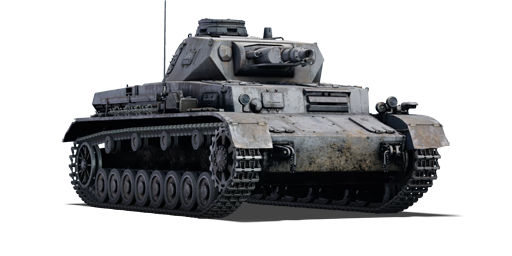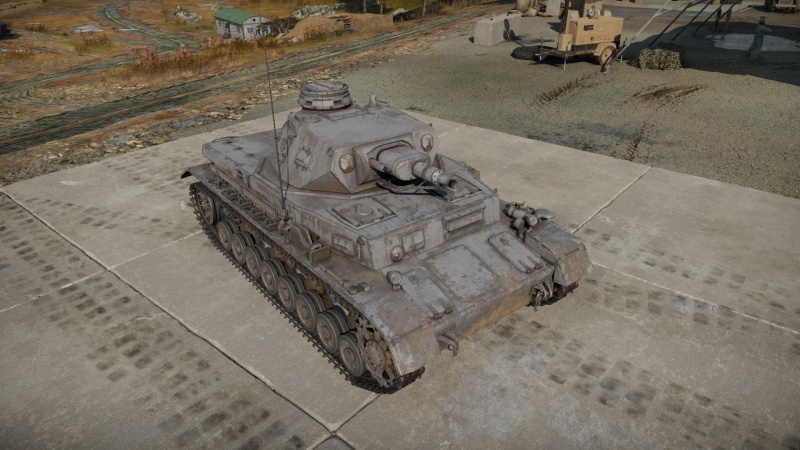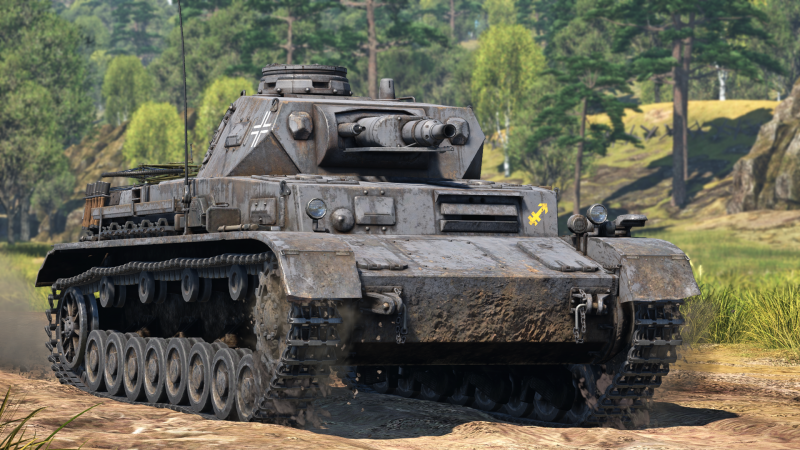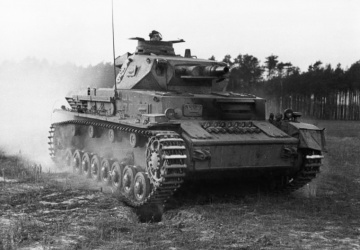Pz.IV C
| This page is about the German medium tank Pz.IV C. For other versions, see Pz.IV (Family). |
Contents
Description
The Panzerkampfwagen IV Ausführung C (Panzer IV C) (Sd.Kfz. Index: Sd.Kfz. 161) is the third variant of the Panzerkampfwagen IV medium tank family, a family of German medium tanks that saw the most production and served on all fronts in many intense conflicts throughout World War II. While the Tiger and Panther are more well-known today, the Panzer IV was the core of Blitzkrieg tactics. The Panzer IVs saw action in all of Germany's battle theatres and were the only German medium tank line that remained in continuous production throughout the war. The development of Panzer IVs began in secrecy in the mid-1930s, since the Germans were theoretically prohibited from developing such vehicles by the Treaty of Versailles, with the first variant, the Panzer IV A, being assembled. Since this was the first variant, there was still plenty of space for refinement. The development of the Panzer IV A version led to the creation of two essentially identical versions, B and C. Armed with a short-barrelled 75 mm Kampfwagenkanone (KwK) 37 L/24 howitzer-like tank gun, which was primarily designed to fire high-explosive shells to support infantry and attack fortifications. The Panzer IVs was originally intended for infantry support, with the Panzer IIIs was intended to engage enemy armoured fighting vehicles. However, in the wake of the formidable T-34, the Germans saw the Panzer IV as having more development potential, with a larger turret ring to equip more powerful weapons, resulting in the creation of the Panzer IV F2.
Introduced in the Closed Beta Test for Ground Forces before Update 1.41, the Panzer IV C was designed for infantry support, much like its American counterpart, the M8 HMC. By firing low-velocity shells in an arc, the Panzer IV C can readily strike opposing vehicles while remaining behind low obstacles. However, since anti-tank weapons were not advanced during its time period, the armour protection was limited to anti-tank rifles. Nonetheless, the Panzer IV C will present players with unique insights into this unique German medium tank family, which will eventually be at the core of German Blitzkrieg tactics throughout World War II.
General info
Survivability and armour
Armour type:
- Rolled homogeneous armour
- Cast homogeneous armour (Cupola)
| Armour | Front (Slope angle) | Sides | Rear | Roof |
|---|---|---|---|---|
| Hull | 30 mm (11°) Front plate 12 mm (72°) Front glacis 30 mm (14°) Lower glacis |
15 mm | 15 mm | 12 mm |
| Turret | 30 mm Turret front 30 mm Gun mantlet |
15 mm | 15 mm | 10 mm |
| Cupola | 15 mm | 15 mm | 15 mm | 10 mm |
Notes:
- Suspension wheels and tracks are 15 mm thick.
- Belly armour is 5 mm thick.
- Hull underside right above tracks is only 5 mm thick.
Mobility
| Game Mode | Max Speed (km/h) | Weight (tons) | Engine power (horsepower) | Power-to-weight ratio (hp/ton) | |||
|---|---|---|---|---|---|---|---|
| Forward | Reverse | Stock | Upgraded | Stock | Upgraded | ||
| Arcade | 48 | 9 | 19.2 | 465 | 572 | 24.22 | 29.79 |
| Realistic | 43 | 8 | 265 | 300 | 13.8 | 15.63 | |
Modifications and economy
- "Parts" and "FPE": you need to be able to repair field damage as well as extinguish fires.
- "Horizontal Drive" and "Hl.Gr 38B": this will increase your turret's traverse speed and the HEAT shell will help deal with more heavily armoured tanks.
- Other firepower modifications.
- Then the remaining modifications.
Armaments
Main armament
| 75 mm KwK37 | Turret rotation speed (°/s) | Reloading rate (seconds) | |||||||||||
|---|---|---|---|---|---|---|---|---|---|---|---|---|---|
| Mode | Capacity | Vertical | Horizontal | Stabilizer | Stock | Upgraded | Full | Expert | Aced | Stock | Full | Expert | Aced |
| Arcade | 80 | -10°/+20° | ±180° | N/A | 13.3 | 18.4 | 22.4 | 24.8 | 26.4 | 4.29 | 3.80 | 3.50 | 3.30 |
| Realistic | 8.3 | 9.8 | 11.9 | 13.2 | 14.0 | ||||||||
Ammunition
| Penetration statistics | |||||||
|---|---|---|---|---|---|---|---|
| Ammunition | Type of warhead |
Penetration @ 0° Angle of Attack (mm) | |||||
| 10 m | 100 m | 500 m | 1,000 m | 1,500 m | 2,000 m | ||
| K.Gr.rot Pz. | APCBC | 52 | 50 | 45 | 39 | 34 | 30 |
| Hl.Gr 38B | HEAT | 80 | 80 | 80 | 80 | 80 | 80 |
| Sprgr. 34 | HE | 10 | 10 | 10 | 10 | 10 | 10 |
| Shell details | ||||||||||||
|---|---|---|---|---|---|---|---|---|---|---|---|---|
| Ammunition | Type of warhead |
Velocity (m/s) |
Projectile mass (kg) |
Fuse delay (m) |
Fuse sensitivity (mm) |
Explosive mass (TNT equivalent) (g) |
Ricochet | |||||
| 0% | 50% | 100% | ||||||||||
| K.Gr.rot Pz. | APCBC | 385 | 6.78 | 1.2 | 14 | 102.4 | 48° | 63° | 71° | |||
| Hl.Gr 38B | HEAT | 450 | 4.57 | 0.05 | 0.1 | 872.1 | 62° | 69° | 73° | |||
| Sprgr. 34 | HE | 420 | 5.74 | 0 | 0.1 | 686 | 79° | 80° | 81° | |||
| Smoke shell characteristics | ||||||
|---|---|---|---|---|---|---|
| Ammunition | Velocity (m/s) |
Projectile mass (kg) |
Screen radius (m) |
Screen deploy time (s) |
Screen hold time (s) |
Explosive mass (TNT equivalent) (g) |
| K.Gr.Rot Nb. | 423 | 6.2 | 13 | 5 | 20 | 50 |
Ammo racks
| Full ammo |
1st rack empty |
2nd rack empty |
3rd rack empty |
4th rack empty |
5th rack empty |
6th rack empty |
7th rack empty |
8th rack empty |
9th rack empty |
Visual discrepancy |
|---|---|---|---|---|---|---|---|---|---|---|
| 80 | 71 (+9) | 65 (+15) | 56 (+24) | 50 (+30) | 42 (+38) | 34 (+46) | 26 (+54) | 3 (+77) | 0 (+0) | No |
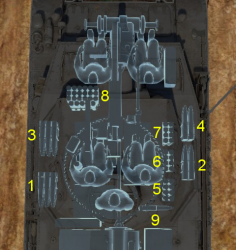
Notes:
- Racks only disappear after all shells in the rack have been fired.
- Turret empty: 50 (+30) shells.
- Flank empty: 26 (+54) shells.
Machine guns
| 7.92 mm MG34 | ||||
|---|---|---|---|---|
| Mount | Capacity (Belt) | Fire rate | Vertical | Horizontal |
| Coaxial | 2,400 (150) | 900 | N/A | N/A |
Usage in battles
The Panzer IV Ausf. C is a fine tank in Rank I due to its high powered yet low-velocity cannon. It is often capable of annihilating an enemy vehicle with a single HE or HEAT shell, regardless of the angle of the enemy's armour. It has a fair amount of armour, however, due to the lack of an actual slope, it may seem considerably more fragile than some Soviet vehicles when facing AP shells. Against Rank I, it is often wiser to close in with the enemy vehicle, counting on the slower turret speed of the Soviet machines, allowing the player to circle around them with ease and deliver devastating shots. Bear in mind that while this tank can easily obliterate any vehicle at its own BR, against higher rank enemies the relatively poor penetration of the gun and very slow shell travel speed can become a problem. Avoiding direct encounters, and using flanking manoeuvres is advisable.
Regarding gameplay, the "Panzer Kampfwagen IV Ausführung C" can be a difficult tank to use. The reason is that while armour and speed are comparable with other tanks of its rank, the gun clearly shows its roots as an infantry support weapon, not designed to fight other tanks. With its low muzzle velocity and low penetration values of basic ammunition, compared to 37 mm and 45 mm guns of the Ausf.C's opposition. Like in the same tree with the Panzer 38(t), it offers similar armour and speed, too.
However, with HEAT ammunition and a skilled player, the Ausf.C can be a great tank. HEAT ammo is difficult to aim due to its very low muzzle velocity which suits it for close combat, but its superb penetration, unmatched by anything in its rank, renders any enemy armour protection useless. Coupled with fast reload times, the Ausf.C can be a surprisingly effective frontline brawler, crippling or destroying enemy tanks regardless of their armour protection. In this role, it's essential to dispatch the enemy before they can fire – the flat armour cannot protect the Panzer IV against anything at point-blank range.
If preferring a safer playstyle, it can lob HEAT shells from afar – this is difficult task to do, but as HEAT ammo does not lose penetration over distance, the Panzer IV C can destroy targets afar as well as up close and the armour may bounce a hit or two from longer distances, it can even cause a good number of tank to hull break, some good examples would be the BT tanks and LVTs. Engaging moving targets is however very challenging.
Despite its low penetration, it's actually not that bad. The statistics may indicate low penetration but remember that the Panzer IV C is at a very low battle rating where it can penetrate actually pretty much any vehicle it faces with normal AP shells. Also, the 75 mm has a very fast rate of fire. The gun size is also fantastic and there are frequent knock-outs with one shot. Don't worry about T-50s, T-126s, and other thicker-armoured early French tanks, the gun can penetrate all of them with either round at its disposal.
Overall, the Pz.Kpfw. IV Ausf. C suffers from its roots as an infantry support tank and many players will avoid it, but if willing to take up the challenge, one could put the HEAT shells to good use and achieve great results. Further research then levels up to another part of the Pz.Kpfw.IV line – the Panzer IV Ausf. E, sporting additional armour and improved HEAT rounds with 100 mm of penetration.
Pros and cons
Pros:
- Destructive firepower against common opponents like the BT-7, M3 Stuarts, etc.
- Main armament offers various shells for all enemy types: a deadly AP for common targets, a penetrating HEAT for heavy vehicles (eg. B1) in an uptier, HE for light vehicles and smoke shell to "blind" the enemies.
- Rapid reload of 3-4 seconds means it's easy to deal with multiple targets.
- Great gun depression of -10° provides nice mountain warfare capacity.
- Adequate speed and cross-country mobility
- Spacious fighting compartment with 5 crew increases survivability, especially when most guns at the battle rating have small calibre and lack damage.
- HEAT can hull break some lightly armoured tanks like the LVT(A)
Cons:
- Thin armour overall plus its large profile, easily gets spotted and penetrated
- Gun has low muzzle velocity and huge drop, which makes distant or moving targets fairly hard to shoot at.
- Turret turns rather slow at around 10°/s, making it hard to quickly respond to flankers like the BT-7.
History
Development
The Pz.Kpfw. IV's creation, like its predecessor the Pz.Kpfw. III, was devised by Heinz Guderian, where he envisioned a support tank to be used to handle anti-tank guns and fortifications. The Panzer IV was to work alongside the more numerable Panzer III in Panzer Divisions (three company of IIIs and one of IVs) to engage the enemy, giving the role of fighting enemy armoured forces to the Panzer IIIs. As a support tank, the tank was to have the short 75 mm howitzer as its main armament and have a weight limit of 24 tons. MAN, Krupp, and Rheinmetall-Borsig worked on the development of the tanks, but the Krupp's model was selected for further testing.
The chosen model from Krupp once finished used a leaf-spring double-bogie system for its suspension, doing away the proposed interleaved or torsion bar suspension system earlier devised for the sake of faster production. The vehicle held five crew members, the commander, gunner, loader, radio operator (and hull machine gunner), and driver. Though it looked symmetrical, the Panzer IV turret was actually offset to the left of the chassis centre line a bit while the engine was also offset to the right, this was to allow the torque shaft to turn the turret. The offset also meant that most of the ammo is held on the right side of the tank in storage areas. The Panzer IV was then accepted into service and production began in 1936.
Panzer IV Ausf. C
The initial Ausf. A variant of the Panzer IV had armour only about 14 mm, enough to stop small arms fire. It quickly moved on to the Ausf. B with a more powerful engine and transmission, and more armour to 30 mm thick. Then the Panzer IV Ausf. C, introduced in 1938, showed up with a better engine and slightly more armour on the turret to 30 mm. The Ausf. C ended with the Panzer IV with the KwK 37 L/24 75 mm howitzer gun that was capable of penetrating 43 mm of armour with armour-piercing rounds. The tank weighed 18 tons in this variant.
The early variant of the Panzer IV Ausf. C and Ausf. D (has 20 mm side armour) saw combat in Poland and France, where its light armour and gun had difficulty against the British Matilda and French Char B1 tanks. A 50 mm Pak 38 cannon was tested on the Ausf. D in response to the threat, but the swift victory of the French campaign ended these tests.
After the initial stages of World War II, the Panzer IV Ausf. C saw further upgrades to its later variants. Its next variant, made in October 1940, was the Panzer IV Ausf. E.
| Archive of the in-game description | |
|---|---|
|
The Pz.Kpfw.IV Ausf. C was the first Pz. IV variant to undergo relatively large-scale production. The tanks were produced from September 1938 to August 1939 in factories belonging to the company Krupp-Gruson. Beginning with the 40th tank to be produced, a Maybach HL 120TRM engine with 265 hp was used. This variant of tank had a specially reinforced stop under the gun barrel which reclined the radio antenna out of the way when the turret was rotated. The coaxial machine gun was fitted with an armoured casing. This variant included a new 6-speed gearbox. The vehicle's speed was increased to 40 km/h. Its forward armour was 16 mm thick. The tank commander received a new commander's cupola. Ausf. C tanks had a modified engine installation and an improved turret rotating ring. On Pz.Kpfw. IV Ausf. C vehicles, the radio operator did not have a directional machine gun but an observation slit and pistol porthole instead. As a result of these improvements, the vehicle's reliability and ease of manufacturing were improved. 140 units were produced in all. This variant of tank participated in every operation during the first part of World War II. The Pz.Kpfw. IV Ausf. C's disadvantages became evident immediately after the attack on the USSR. The width of the tank tread did not provide adequate cross-country ability over soft terrain and snow-covered surfaces. The short-barreled 7,5 cm KwK 37 L/24 gun, with a muzzle velocity of 385 m/s for an armour-piercing projectile, was completely ineffective against heavily armoured tanks like the British Matilda and the Soviet KV and T-34. The Pz.Kpfw. IV Ausf. C tank fought in combat operations until 1943. | |
Media
- Skins
- Sights
See also
Links to the articles on the War Thunder Wiki that you think will be useful for the reader, for example:
- reference to the series of the vehicles;
- links to approximate analogues of other nations and research trees.
External links
| Germany medium tanks | |
|---|---|
| Pz.III | Pz.III B · Pz.III E · Pz.III F · Pz.III J · Pz.III J1 · Pz.III J1 TD · Pz.III L · Pz.III M · Pz.III N |
| Pz.IV | Pz.IV C · Pz.IV E · Pz.IV F1 · Pz.IV F2 · Pz.IV G · Pz.IV H · Pz.IV J · Pz.Bef.Wg.IV J |
| Pz.V | VK 3002 (M) · Panther A · Panther D · Panther F · Panther G · Ersatz M10 · Panther II |
| M48 upgrades | M48A2 G A2 · M48 Super |
| Leopard 1 | Leopard I · Leopard A1A1 · Leopard A1A1 (L/44) · Leopard 1A5 · C2A1 · Turm III |
| Leopard 2 | PT-16/T14 mod. · Leopard 2K · Leopard 2AV |
| Leopard 2A4 · Leopard 2 (PzBtl 123) · Leopard 2 PL · Leopard 2A5 · Leopard 2 PSO · Leopard 2A6 · Leopard 2A7V | |
| Trophies | ▀M4 748 (a) · ▀T 34 747 (r) |
| Other | Nb.Fz. · KPz-70 |
| USA | mKPz M47 G · M48A2 C |
| USSR | ◊T-72M1 |


